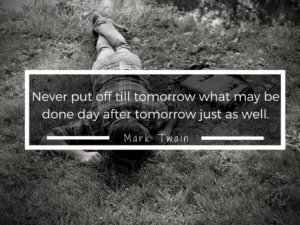Slaying your Procrastination Demons. Part 3/4
 Today is the 3rd post in a 4-part series on conquering your procrastination demons. In the first post, we identified which of the top 7 types of writer’s block are causing us to procrastinate. In the second post, I talked more about the first 3 types of writer’s block and offered some targeted strategies that can help with these specific issues. Today we’ll move on to look at the last 4 types. And then, in the final post in this series I’ll talk about simple strategies to get you writing with ease.
Today is the 3rd post in a 4-part series on conquering your procrastination demons. In the first post, we identified which of the top 7 types of writer’s block are causing us to procrastinate. In the second post, I talked more about the first 3 types of writer’s block and offered some targeted strategies that can help with these specific issues. Today we’ll move on to look at the last 4 types. And then, in the final post in this series I’ll talk about simple strategies to get you writing with ease.
So let’s get started. Quick recap: We’ve already covered procrastination, work apprehension and writing apprehension. Carrying on from there, the next common type of writer’s block is:
4. Dysphoria
This is a more extreme version of writer’s apprehension (which we covered in the last post). For these folks, writing is truly scary and leads to generalized feelings of being ill; especially abnormal feelings of anxiety, discontent, and physical discomfort. This fear is as real as other phobias; like having fear of flying, being afraid of snakes or spiders, etc. If this describes you, you may need to seek professional help to overcome this fear. The good news is that similar to writing apprehension, positive experiences with writing build confidence and reduces anxiety over time.

5. Impatience
For these folks, writing is a race. Impatience is characterized by by sense of urgency, where not enough pre-writing gets done (i.e., note taking, reflection, outlining). Impatient writers don’t allow enough time for the preparation that good writing demands; rewriting, proof-reading, error-free form. Consequently, not enough writing gets done in a comfortable, non-fatiguing fashion. People feel obsessed about being behind, incapable of working fast enough. This type of writer’s block often goes hand-in-hand with the second type we covered: work apprehension. Putting things off generally leaves you crunched for time, which can exacerbate the problem for impatient writers.
Improvement depends on developing a willingness to learn new habits of writing: writing regularly, in moderate sessions, with slow, steady productivity.
The key to everything is PATIENCE. (After all), You get the chicken by hatching the egg, not by smashing it.
Arnold H. Glascow
6. Perfectionism
 Being a perfectionist can impede progress. It disrupts momentum and because of its circular nature – going back over what has already been written down over and over – it is extremely time consuming. If you are a perfectionist, you likely face the worst blocking during your early drafts, due to the time spent rewriting. Your internal critic can often be traced back to experiences with important authority figures in your life, such as teachers and mentors.
Being a perfectionist can impede progress. It disrupts momentum and because of its circular nature – going back over what has already been written down over and over – it is extremely time consuming. If you are a perfectionist, you likely face the worst blocking during your early drafts, due to the time spent rewriting. Your internal critic can often be traced back to experiences with important authority figures in your life, such as teachers and mentors.
This type of blocking is very difficult to give up since it’s hard to break the pattern of being a closet elitist. In order to do so, you need to implement some writing rules – such as, “I will write freely without any editing (not even to fix spelling mistakes) for at least 30 minutes.” Your mantra should be: Done is better than perfect. Once your first draft is done, you can unleash your perfectionist streak and edit, revise, and rewrite to your heart’s content.
7. Rules
The final form of writer’s block is manifested by those who are overly rigid in how they approach writing. If you find yourself thinking: “I can only write late at night, in my bedroom, with my laptop resting on my knees, headphones on and a specific playlist streaming“, then you might suffer from being blocked by your writing routines. Routines are usually helpful strategies to overcome other forms of writer’s block; but for you, they are overly rigid, inflexible, and stubborn. And thus, they interfere with efficient, painless writing. By focusing on choosing flexible and recursive approaches and pushing yourself to write under novel conditions, you can easily overcome this writing problem.

All right, now we’ve covered all 7 of the common types of writer’s block. By now you should have a good understanding of what it is that stands in your way from becoming comfortable with writing. In the next and final post of this series, we’ll tackle some amazingly simple strategies that will have you writing with ease in no time and clear the way for you to get things to DONE.
Find your spark and start a fire now!
Kim


